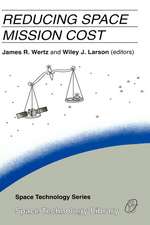Space Mission Analysis and Design: Space Technology Library, cartea 2
Editat de Wiley J. Larson, A.V. Wertzen Limba Engleză Paperback – 5 oct 2013
Din seria Space Technology Library
- 20%
 Preț: 569.37 lei
Preț: 569.37 lei - 17%
 Preț: 363.73 lei
Preț: 363.73 lei - 20%
 Preț: 476.04 lei
Preț: 476.04 lei - 18%
 Preț: 947.98 lei
Preț: 947.98 lei - 15%
 Preț: 643.99 lei
Preț: 643.99 lei - 18%
 Preț: 1688.57 lei
Preț: 1688.57 lei - 18%
 Preț: 957.75 lei
Preț: 957.75 lei - 18%
 Preț: 1393.27 lei
Preț: 1393.27 lei -
 Preț: 393.35 lei
Preț: 393.35 lei - 18%
 Preț: 956.03 lei
Preț: 956.03 lei - 15%
 Preț: 647.08 lei
Preț: 647.08 lei - 24%
 Preț: 1057.68 lei
Preț: 1057.68 lei - 18%
 Preț: 1215.04 lei
Preț: 1215.04 lei - 24%
 Preț: 810.45 lei
Preț: 810.45 lei - 18%
 Preț: 1009.08 lei
Preț: 1009.08 lei - 18%
 Preț: 960.78 lei
Preț: 960.78 lei - 18%
 Preț: 947.50 lei
Preț: 947.50 lei - 15%
 Preț: 584.92 lei
Preț: 584.92 lei - 15%
 Preț: 647.40 lei
Preț: 647.40 lei - 18%
 Preț: 1834.77 lei
Preț: 1834.77 lei - 15%
 Preț: 590.16 lei
Preț: 590.16 lei - 15%
 Preț: 600.30 lei
Preț: 600.30 lei - 15%
 Preț: 713.33 lei
Preț: 713.33 lei - 23%
 Preț: 739.84 lei
Preț: 739.84 lei - 18%
 Preț: 998.66 lei
Preț: 998.66 lei - 23%
 Preț: 748.98 lei
Preț: 748.98 lei
Preț: 429.69 lei
Nou
Puncte Express: 645
Preț estimativ în valută:
82.23€ • 85.36$ • 68.57£
82.23€ • 85.36$ • 68.57£
Carte tipărită la comandă
Livrare economică 18-24 martie
Preluare comenzi: 021 569.72.76
Specificații
ISBN-13: 9789401051927
ISBN-10: 9401051925
Pagini: 924
Ilustrații: XXXVIII, 878 p. In 2 volumes, not available separately.
Dimensiuni: 160 x 240 x 32 mm
Greutate: 0.77 kg
Ediția:2nd ed. 1992
Editura: SPRINGER NETHERLANDS
Colecția Springer
Seria Space Technology Library
Locul publicării:Dordrecht, Netherlands
ISBN-10: 9401051925
Pagini: 924
Ilustrații: XXXVIII, 878 p. In 2 volumes, not available separately.
Dimensiuni: 160 x 240 x 32 mm
Greutate: 0.77 kg
Ediția:2nd ed. 1992
Editura: SPRINGER NETHERLANDS
Colecția Springer
Seria Space Technology Library
Locul publicării:Dordrecht, Netherlands
Public țintă
ResearchCuprins
1. The Space Mission Analysis and Design Process.- 1.1 Introduction and Overview.- 1.2 The Space Mission Life Cycle.- 1.3 Definition of Mission Objectives.- 1.4 Preliminary Estimate of Mission Needs, Requirements, and Constraints.- 2. Mission Characterization.- 2.1 Identifying Alternative Mission Concepts.- 2.2 Identifying Alternative Mission Architectures.- 2.3 Identifying System Drivers.- 2.4 Characterizing the Mission Architecture.- 3. Mission Evaluation.- 3.1 Identification of Driving Requirements.- 3.2 Mission Analysis.- 3.3 Mission Utility.- 3.4 Mission Concept Selection.- 4. Requirements Definition.- 4.1 Role of Requirements in System Development.- 4.2 Requirements Analysis and Performance Budgeting.- 4.3 Requirements Specification.- 4.4 Summary: The Steps to a Requirements Baseline.- 5. Space Mission Geometry.- 5.1 Introduction to Geometry on the Celestial Sphere.- 5.2 Earth Geometry Viewed from Space.- 5.3 Apparent Motion of Satellites for an Observer on the Earth.- 5.4 Development of Mapping and Pointing Budgets.- 6. Introduction to Astrodynamics.- 6.1 Keplerian Orbits.- 6.2 Orbit Perturbations.- 6.3 Orbit Maneuvering.- 6.4 Launch Windows.- 6.5 Orbit Maintenance.- 7. Orbit and Constellation Design.- 7.1 The Orbit Design Process.- 7.2 Earth Coverage.- 7.3 The Delta-V Budget.- 7.4 Selecting Orbits for Earth-Referenced Spacecraft.- 7.5 Selecting Transfer, Parking, and Space-Referenced Orbits.- 7.6 Constellation Design.- 8. The Space Environment and Survivability.- 8.1 The Space Environment.- 8.2 Hardness and Survivability Requirements.- 9. Defining and Sizing Space Payloads.- 9.1 Types of Payloads.- 9.2 Overview of Payload Design and Sizing.- 9.3 Subject Trades.- 9.4 Overview of Observation Payloads.- 9.5 Designing Visual and IR Payloads.- 9.6 Payload Sizing.- 9.7 The FireSat Payload.- 10. Spacecraft Design and Sizing.- 10.1 Requirements, Constraints, and the Design Process.- 10.2 Spacecraft Configuration.- 10.3 Design Budgets.- 10.4 Designing the SpacecraftBus.- 10.5 Integrating the Spacecraft Design.- 10.6 Examples.- 11. Spacecraft Subsystems.- 11.1 Attitude Determination and Control.- 11.2 Communications.- 11.3 Command and Data Handling.- 11.4 Power.- 11.5 Thermal.- 11.6 Structures and Mechanisms.- 11.7 Guidance and Navigation.- 12. Spacecraft Manufacture and Test.- 12.1 Engineering Data.- 12.2 Manufacture of High-Reliability Hardware.- 12.3 Inspection and Quality Assurance.- 12.4 The Qualification Program.- 12.5 Spacecraft Qualification Test Flow.- 12.6 Launch Site Operations.- 13. Communications Architecture.- 13.1 Communications Architecture.- 13.2 Data Rates.- 13.3 Link Design.- 13.4 Sizing the Payload.- 13.5 Special Topics.- 14. Mission Operations.- 14.1 Overview of Mission Operations.- 14.2 Spacecraft Operations.- 14.3 Personnel Training.- 14.4 Mission Planning.- 14.5 Engineering Support.- 15. Ground System Design and Sizing.- 15.1 The Ground System Design Process.- 15.2 A Ground System’s Basic Elements.- 15.3 The Typical GroundSystem.- 15.4 Alternatives To Building a Dedicated System.- 15.5 Key Design Considerations.- 16. Spacecraft Computer Systems.- 16.1 Allocating Requirements.- 16.2 Computer Resource Estimation.- 16.3 Development, Test, and Integration.- 17. Space Propulsion Systems.- 17.1 Propulsion Subsystem Selection and Sizing.- 17.2 Basics of Rocket Propulsion.- 17.3 Types of Rockets.- 17.4 Component Selection and Sizing.- 17.5 Staging.- 18. Launch Systems.- 18.1 Basic Launch Vehicle Considerations.- 18.2 Launch System Selection Process.- 18.3 Determining the Spacecraft Design Envelope and Environments.- 19. Space Logistics and Reliability.- 19.1 Space Logistics.- 19.2 Reliability During Space Mission Concept Exploration.- 20. Cost Modeling.- 20.1 Introduction to Cost Analysis.- 20.2 The Parametric Cost Estimation Process.- 20.3 Cost Estimating Relationships.- 20.4 Other Topics.- 20.5 FireSat Example.- 21. Limits on Mission Design.- 21.1 Law and Policy Considerations.- 21.2 Orbital Debris—A Man-madeHazard.- 22. Design of Low-Cost Spacecraft.- 22.1 Designing Low-Cost Space Systems.- 22.2 Small Space Systems Capabilities and Applications.- 22.3 Applying Miniature Satellite Technology to FireSat.- 22.4 Scaling from Large to Small Systems.- 22.5 Economics of Low-Cost Space Systems.- 22.6 Annotated Bibliography on Low-Cost Space Systems.- Epilogue. Applying Space Mission Analysis and Design.- E.1 Applying SMAD to Later Mission Phases.- E.2 Lessons Learned from Existing Space Programs.- E.3 Future Trends.- Appendix A. Mass Distribution for Selected Satellites.- Appendix B. Astronautical and Astrophysical Data.- Appendix C. Standard Notation.- Appendix D. Spherical Geometry Formulas.- Appendix E. Units and Conversion Factors.- Spaceflight Formulas.- Fundamental Physical Constants.- Spaceflight Constants.- Index to Process Tables.- Earth Satellite Parameters.
















